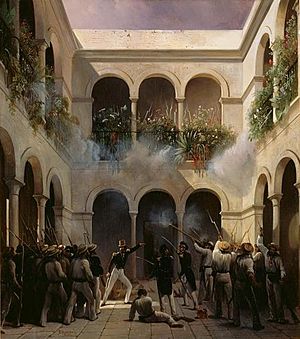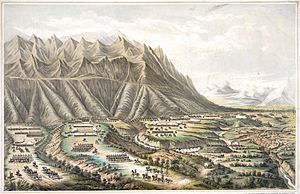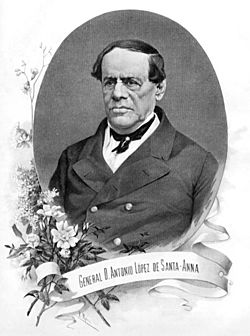Antonio López de Santa Anna facts for kids
Quick facts for kids
Antonio López de Santa Anna
|
|
|---|---|
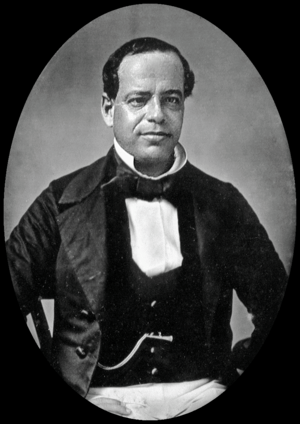
Daguerreotype of General Santa Anna, c. 1853
|
|
| 8th President of Mexico | |
| In office 20 April 1853 – 5 August 1855 |
|
| Preceded by | Manuel María Lombardini |
| Succeeded by | Martín Carrera |
| In office 20 May 1847 – 15 September 1847 |
|
| Preceded by | Pedro María de Anaya |
| Succeeded by | Manuel de la Peña y Peña |
| In office 21 March 1847 – 2 April 1847 |
|
| Preceded by | Valentín Gómez Farías |
| Succeeded by | Pedro María de Anaya |
| President of the Mexican Republic | |
| In office 4 June 1844 – 12 September 1844 |
|
| Preceded by | Valentín Canalizo |
| Succeeded by | José Joaquín de Herrera |
| In office 14 May 1843 – 6 September 1843 |
|
| Preceded by | Nicolás Bravo |
| Succeeded by | Valentín Canalizo |
| In office 10 October 1841 – 26 October 1842 |
|
| Preceded by | Francisco Javier Echeverría |
| Succeeded by | Nicolás Bravo |
| In office 20 March 1839 – 10 July 1839 |
|
| Preceded by | Anastasio Bustamante |
| Succeeded by | Nicolás Bravo |
| President of the United Mexican States | |
| In office 24 April 1834 – 27 January 1835 |
|
| Preceded by | Valentín Gómez Farías |
| Succeeded by | Miguel Barragán |
| In office 27 October 1833 – 15 December 1833 |
|
| Preceded by | Valentín Gómez Farías |
| Succeeded by | Valentín Gómez Farías |
| In office 18 June 1833 – 5 July 1833 |
|
| Preceded by | Valentin Gómez Farías |
| Succeeded by | Valentín Gómez Farías |
| In office 17 May 1833 – 4 June 1833 |
|
| Preceded by | Valentín Gómez Farías |
| Succeeded by | Valentín Gómez Farías |
| Vice President of the Mexican Republic | |
| In office 16 April 1837 – 17 March 1839 |
|
| President | Anastasio Bustamante |
| Preceded by | Valentin Gomez Farias |
| Succeeded by | Nicolas Bravo |
| Personal details | |
| Born | 21 February 1794 Xalapa, Veracruz, New Spain |
| Died | 21 June 1876 (aged 82) Mexico City, Mexico |
| Resting place | Panteón del Tepeyac, Mexico City |
| Political party | Liberal (until 1833) Conservative (from 1833) |
| Spouses |
María Inés de la Paz García
(m. 1825; died 1844)María de los Dolores de Tosta
(m. 1844) |
| Awards | |
| Signature |  |
| Nickname | The Napoleon of the West |
| Military service | |
| Allegiance | |
| Years of service | 1810–1855 |
| Rank | General |
Antonio López de Santa Anna (born February 21, 1794 – died June 21, 1876) was a very important Mexican general and politician. He was often called Santa Anna or López de Santa Anna. He served as president of Mexico many times.
Santa Anna was a key figure in Mexican history for about 30 years after Mexico became independent. This time is sometimes called the "Age of Santa Anna." People even called him "the Napoleon of the West" because of his strong leadership.
He played a big part in many major events. These included the fall of Mexico's first empire and republic, the Texas Revolution, and the Mexican–American War. He was known for changing his political side, sometimes supporting liberals and sometimes conservatives. He often used the military to get his way.
Many historians now see his time in power as negative for Mexico. During his leadership, Mexico lost Texas and other large territories to the United States. He died in 1876, after spending many years in exile.
Contents
Early Life and Military Start
Antonio López de Santa Anna was born in Xalapa, Veracruz, in what was then called New Spain. This was on February 21, 1794. His family was respected but not super rich. They were part of the criollo group, meaning they were Spaniards born in America.
His mother supported his dream of joining the army, even though he was underage. This helped him get a military job. Being from Veracruz, he was used to the local climate. This gave him an advantage against soldiers from other regions who might get sick.
Becoming a military officer was a way for him to become a leader. He was good in battle, which helped him rise in politics. He liked to connect with ordinary people and enjoyed things like cockfighting. He became a powerful leader, known as a caudillo, who held both military and political power.
Fighting for the Crown
Santa Anna started his military career in June 1810, joining an infantry regiment. At this time, Mexico was fighting for its independence from Spain. Like most officers born in America, Santa Anna first fought for the Spanish king against the rebels.
He learned a lot from his commander, José Joaquín de Arredondo, about dealing with rebels. In 1811, Santa Anna was hurt in his left hand during a fight. In 1813, he fought in Texas and was praised for his bravery. He was promoted quickly, becoming a first lieutenant by the end of 1812. He saw how his commander dealt with rebels by executing many of them.
Joining the Independence Movement
In 1821, a royalist officer named Agustín de Iturbide switched sides and joined the rebels. Santa Anna also decided to join the fight for Mexico's independence. This change happened because Spain's government was changing, which made many Mexican elites rethink their loyalty.
Becoming a Leader in the New Republic
After Mexico won its independence, Iturbide became emperor. He put Santa Anna in charge of the important port of Veracruz. But Iturbide later removed Santa Anna from this job. This made Santa Anna angry, and he started a rebellion against Iturbide in December 1822.
Santa Anna said he was rebelling because Iturbide had closed the Congress. He also promised to support free trade, which was important for Veracruz. Other rebel leaders joined the fight against Iturbide. They wanted to end the monarchy and create a republic.
Early Mexican Republic
In 1824, Mexico became a republic with a new constitution. Guadalupe Victoria became the first president. In 1828, there was a lot of political fighting during the next election. Santa Anna supported Vicente Guerrero for president.
When another candidate, Manuel Gómez Pedraza, won, Santa Anna rebelled. He said the election results should be canceled. His rebellion grew, and eventually, Gómez Pedraza resigned. This allowed Guerrero to become president. Santa Anna became well-known as a national leader who defended federalism and democracy.
Hero of Tampico
In 1829, Spain tried to take Mexico back. They invaded Tampico with 2,600 soldiers. Santa Anna led a smaller Mexican force against them. He defeated the Spanish, many of whom were sick with yellow fever.
This victory made Santa Anna very popular. It also made Mexico's independence stronger. He was called a hero and started calling himself "The Victor of Tampico" and "The Savior of the Patria." He even gave himself the nickname "The Napoleon of the West."
President and Reforms
In 1832, Santa Anna rebelled against the current president, Anastasio Bustamante. The fighting ended with new elections in 1833, which Santa Anna won easily. He became president on April 1, 1833.
However, Santa Anna didn't really want to govern. He let his vice president, Valentín Gómez Farías, handle the daily tasks. Gómez Farías and the Congress tried to make big changes. They wanted to reduce the power of the Catholic Church and the army. They also tried to sell church property to help the government's money problems.
These changes made many conservatives angry. As people turned against the reforms, Santa Anna returned to the presidency. Gómez Farías resigned, and conservatives began to change Mexico's government from a federal system (where states have more power) to a central system (where the main government has more power).
The Central Republic and Texas
In 1835, Santa Anna changed the 1824 constitution to the "Siete Leyes" (Seven Laws). This made the central government much stronger. Many states rebelled against these changes, including Zacatecas and Coahuila y Tejas (which included Texas).
Santa Anna crushed the rebellion in Zacatecas. His army looted the city for two days. Then, he planned to go to Texas to stop the rebellion there.
Texas Revolution
The Texas Revolution began in late 1835. American settlers in Texas were upset about the new centralist government. They declared independence on March 2, 1836. Santa Anna marched north with his army to bring Texas back under Mexican control.
His journey was very difficult. His army faced cold weather and lacked food and supplies. Many soldiers were sick. At the Battle of the Alamo, Santa Anna's forces killed all the Texan defenders on March 6, 1836. He also ordered the execution of over 342 Texan prisoners at the Goliad Massacre.
These actions gave the Texan army, led by General Sam Houston, time to gather strength. On April 21, 1836, Houston's army completely defeated Santa Anna's much larger army at the Battle of San Jacinto. The Texans shouted, "Remember Goliad, Remember the Alamo!"
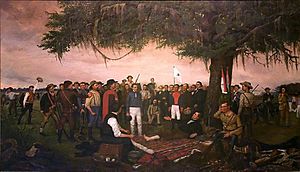
The day after the battle, Santa Anna was captured hiding in a marsh. He signed the Treaties of Velasco, agreeing to Texas's independence. However, the new Mexican government said Santa Anna was no longer president and that the treaty was not valid. Santa Anna was sent to the U.S. for a time, where he met President Andrew Jackson.
Redemption and Return to Power

After his exile, Santa Anna was allowed to return to Mexico in 1837. He went to his home in Veracruz. In 1838, he had a chance to regain his reputation. France sent forces to Veracruz in what was called the Pastry War.
Santa Anna led the Mexican army against the French. During a battle, he was hit by cannon fire in his left leg and hand. His leg was badly damaged and had to be amputated. He ordered his amputated leg to be buried with full military honors. Even though Mexico lost the war, Santa Anna used his sacrifice to the nation to get back into politics.
Soon after, Santa Anna became president for the fifth time. He ruled more like a dictator, banning newspapers that criticized him and jailing people who disagreed. He also tried to raise taxes, which made people angry. Several Mexican states stopped dealing with the central government.
In December 1844, Santa Anna stepped down and tried to escape. A mob dug up his buried leg and dragged it through the streets. He was captured and exiled to Cuba.
Mexican–American War
In 1846, the Mexican–American War began. Mexican troops lost two big battles. Many Mexicans wanted Santa Anna to return from exile to lead the army. The U.S. President James K. Polk thought Santa Anna would help make a deal for land. But Santa Anna tricked them. Once he was back in Mexico, he led the fight against the U.S. invasion.
Santa Anna was still popular, and many Mexicans believed he was the best person to lead them through the war. He quickly moved his troops north to fight the U.S. army. At the Battle of Buena Vista in February 1847, Santa Anna's forces were larger but tired and poorly equipped. After two days of hard fighting, Santa Anna withdrew, claiming victory.
Then, U.S. forces landed at Veracruz, Santa Anna's home. He moved south to protect the capital. He set up defenses at Cerro Gordo, but the U.S. forces outsmarted him and defeated his army. This opened the way for the U.S. to march towards Mexico City.
Santa Anna tried to defend the capital at all costs. He fought hard in several battles, but his forces kept losing. The U.S. forces eventually took Mexico City. Santa Anna's determination to fight prolonged the war for about a year.
During the Battle of Cerro Gordo, Santa Anna's prosthetic cork leg was captured by U.S. soldiers. It is now a war trophy in the U.S. at the Illinois State Military Museum. He had a replacement leg made, which is displayed in a museum in Mexico City.
Last Time as President
After the Mexican–American War ended in 1848, Santa Anna went into exile again. In 1853, conservatives invited him back to be president. He declared himself dictator-for-life and called himself "Most Serene Highness."
One of his biggest mistakes during this time was selling land to the U.S. in what was called the Gadsden Purchase. This land was in northwest Mexico and was wanted for a railroad. Santa Anna sold it for money that was supposed to go to Mexico's empty treasury.
In 1855, a group of liberals overthrew Santa Anna. He went into exile once more.
Personal Life
Santa Anna married twice. Both times, he married wealthy young women. He didn't even attend his own wedding ceremonies, letting others stand in for him. This suggests he was mainly interested in the money these marriages brought him.
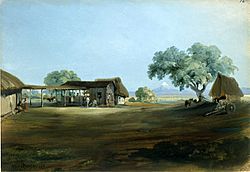
In 1825, he married Inés García. Her family was rich, and her dowry helped Santa Anna buy his favorite hacienda, Manga de Clavo, in Veracruz. A visitor once described his first wife, Inés, offering a cigar from a gold case with a diamond latch.
Two months after Inés died in 1844, the 50-year-old Santa Anna married 16-year-old María de Los Dolores de Tosta. They rarely lived together and had no children. Santa Anna also had several children outside of his marriages.
Later Years and Death
From 1855 to 1874, Santa Anna lived in exile in different countries. He tried to make money through gambling and businesses. He was also a big fan of cockfighting and had many roosters for competitions.
In the 1850s, he brought a substance called chicle to New York. He wanted to sell it for buggy tires, but it didn't work out. However, an American named Thomas Adams, who was helping Santa Anna, experimented with chicle. Adams ended up starting the chewing gum industry with a product he called "chiclets."
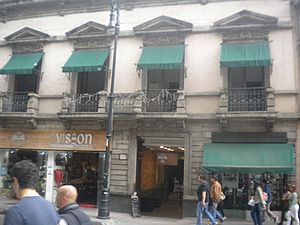
In 1865, he tried to return to Mexico to help during the French invasion, but he was refused. In 1874, he was finally allowed to return to Mexico. He was old, crippled, and almost blind.
Antonio López de Santa Anna died at his home in Mexico City on June 21, 1876, at the age of 82. He was buried with full military honors.
Legacy
Santa Anna was a very controversial figure throughout his life and even after his death. He was seen as a strong military leader and a revolutionary. He often presented himself as someone who could bring peace to Mexico during times of political fighting. He was always more ready to lead an army than to lead the country as a politician.
See Also
 In Spanish: Antonio López de Santa Anna para niños
In Spanish: Antonio López de Santa Anna para niños
- History of democracy in Mexico
- List of heads of state of Mexico
Images for kids
-
Military action in Pueblo Viejo during the Battle of Tampico, September 1829.
-
Dr. Valentín Gómez Farías, López de Santa Anna's vice president 1833–34, who enacted liberal reforms.
-
Portrait of Doña Dolores Tosta de Santa Anna by Juan Cordero, 1855.



